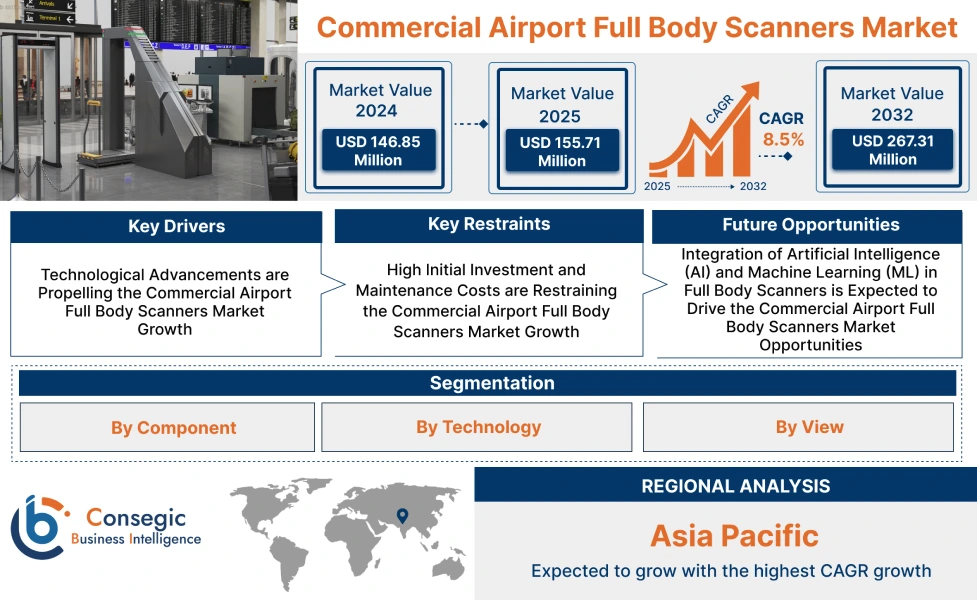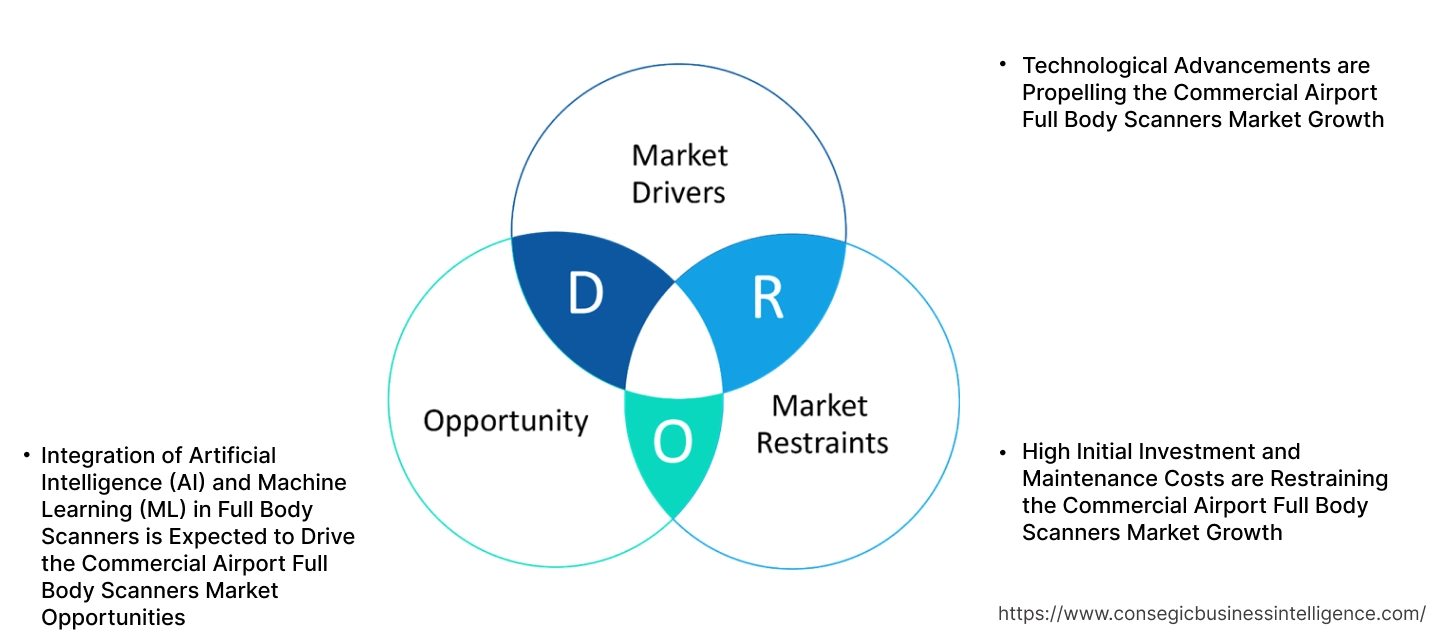Commercial Airport Full Body Scanners Market Size:
Commercial Airport Full Body Scanners Market is estimated to reach over USD 267.31 Million by 2032 from a value of USD 146.85 Million in 2024 and is projected to grow by USD 155.71 Million in 2025, growing at a CAGR of 8.5% from 2025 to 2032.
Commercial Airport Full Body Scanners Market Scope & Overview:
Commercial airport full body scanners refer to full body scanners used in commercial airports for the purpose of securing the airport. Unlike metal detectors that only detect metal objects, full body scanners can detect non-metal objects, which are becoming increasingly important for security in airports. Further, commercial airport full body scanners have experienced growth due to the increasing need to secure commercial airports from terrorist threats. Detection of metal and non-metal prohibited objects like knives, drugs, weapons, and other contraband has resulted in growth in the market.
Commercial Airport Full Body Scanners Market Dynamics - (DRO) :
Key Drivers:
Technological Advancements are Propelling the Commercial Airport Full Body Scanners Market Growth
Full body scanners used in commercial airports have experienced technological advancements in the detection of concealed objects in or on the body. Many full body scanners today can detect objects with high accuracy and low false-positive rates. Moreover, full body scanners can complete a head-to-toe inspection of the body to detect objects or narcotics with high-quality images. Further, the inspection can be done within seconds, and output is displayed on a screen within seconds, making the scanning process quick and hassle-free.
- For instance, Smiths Detection offers a full body X-ray scanner called B-SCAN that can scan a person and generate the scanned image within 7 seconds.
Hence, the technological advancements in full body scanners are driving the market.
Key Restraints:
High Initial Investment and Maintenance Costs are Restraining the Commercial Airport Full Body Scanners Market Growth
Full body scanners in airports use specialized and expensive hardware components, including sensors and software that use advanced algorithms for effective and accurate scanning. Further, the implementation of full body scanners requires high initial costs as compared to investments in walk-through metal detectors due to the presence of specific components, including antennas, transmitters, receivers, and displays.
Moreover, the scanners also require initial costs in the form of training for airport staff, as specialized training is required to scan and interpret the images to identify potential threats, which affects the commercial airport full body scanners market demand. Thus, as per the commercial airport full body scanners market analysis, the high initial investments and maintenance costs due to specialized hardware and software components act as a restraint to the commercial airport full body scanners market demand.
Future Opportunities :
Integration of Artificial Intelligence (AI) and Machine Learning (ML) in Full Body Scanners is Expected to Drive the Commercial Airport Full Body Scanners Market Opportunities
Many companies today are deploying AI and ML algorithms in full body scanners to help the scanning process in commercial airports become easier and more accurate. AI and ML algorithms can help in anomaly detection using computer vision technologies, reducing the false alarm rate. The algorithms can be trained on real threat objects that can be expected in an airport to automatically detect a wide range of threats. Further, using AI and ML, the full body scanners can detect objects that are prohibited with high probability within seconds, which can help in the commercial airport full body scanners market expansion.
- For instance, Linev Systems has developed software that can be used along with the full body scanners to scan full body accurately. The software uses AI and ML algorithms to detect objects with high probability at airport security checkpoints.
Thus, rising technological advancements are projected to drive the commercial airport full body scanners market opportunities during the forecast period.
Commercial Airport Full Body Scanners Market Segmental Analysis :
By Component:
Based on the component, the market is segmented hardware, software, and services.
Trends in the component:
- Increasing trend of technological advancements in emitters, sensors, and alarms, among others, is driving the market growth.
- Rising trends of utilization of software that uses government-certified algorithms for high detection rates and specialized detection algorithms for asset protection.
Hardware accounted for the largest revenue share of 45.89% in the year 2024.
- The physical hardware components of full body scanners include transmitters, light barriers, detectors, a processing system, and alarms, among others.
- Many manufacturers of full body scanners have started using trigger alarms to detect people who pass through without being scanned, resulting in the commercial airport full body scanners market expansion.
- Moreover, companies have started offering software that can measure alarm rates/pass rates and help in identifying areas of increased alarms.
- For instance, Rohde and Schwarz offers light barriers and alarms to detect the persons who have bypassed the scanning process, which helps make airports more secure.
- Thus, rising technological advancements and increasing use of software are driving commercial airport full body scanners market trends.
Software is anticipated to register the fastest CAGR during the forecast period.
- Companies in the commercial airport full body scanners industry have started offering software that integrates with full body scanners for efficient handling of data.
- Many companies offer software that can handle multi-vendor full body scanners and datasets into one single software platform, which in turn drives the commercial airport full body scanners market
- Increasing trend in use of AI is driving the segment as AI can help with automated object detection, which can help reduce operational overheads.
- For instance, Smiths Detection offers a software platform for the handling of multi-vendor devices, including full body scanners on a single platform called Electora.
- Thus, the growing software segment is driving the commercial airport full body scanners market during the forecast period.
By Technology:
Based on technology, the market is segmented into millimetre wave and X-ray.
Trends in the technology:
- Rising trend towards use of safe millimetre wave (MMW) technology to detect both metallic and non-metallic objects.
- Factors including high-quality images, fast scans, and advanced detection of objects are driving the X-ray segment.
Millimetre wave accounted for the largest revenue share in the year 2024.
- Millimetre wave full body scanners emit radiation that is non-ionizing to produce images of the body. Also, non-ionizing radiations are considered to be safe for the human body, which has resulted in the use of full body scanners that use millimetre waves.
- Moreover, manufacturers offer full body scanners that consume low power and offer scanning solutions for people who use wheelchairs.
- For instance, InsTech offers MW1000AA, a full body scanner that uses millimetre radio wave technology to detect concealed objects in airports. The full body scanner also features wheelchair accessibility, low power consumption, and a small footprint.
- Therefore, the millimetre wave segment has witnessed growing demand during the forecast period, driving the commercial airport full body scanners market size.
X-ray is anticipated to register the fastest CAGR during the forecast period.
- X-ray segments have experienced growing use in commercial airports due to an increase in technological aspects of low dose transmission scans.
- Many companies include processing software within the X-ray scans for accurate and high-quality imaging of full body and abdomen.
- The ability to customize the image processing in X-ray full body scanners with different functionalities, like real-time imaging, and one-click scan has driven the segment
- For instance, InsTech offers full body X-ray scanner series called NUCTECH HT2100 SV that are customizable with options like remote control and centralised management.
- Thus, the X-ray segment has witnessed increasing demand during the forecast period.
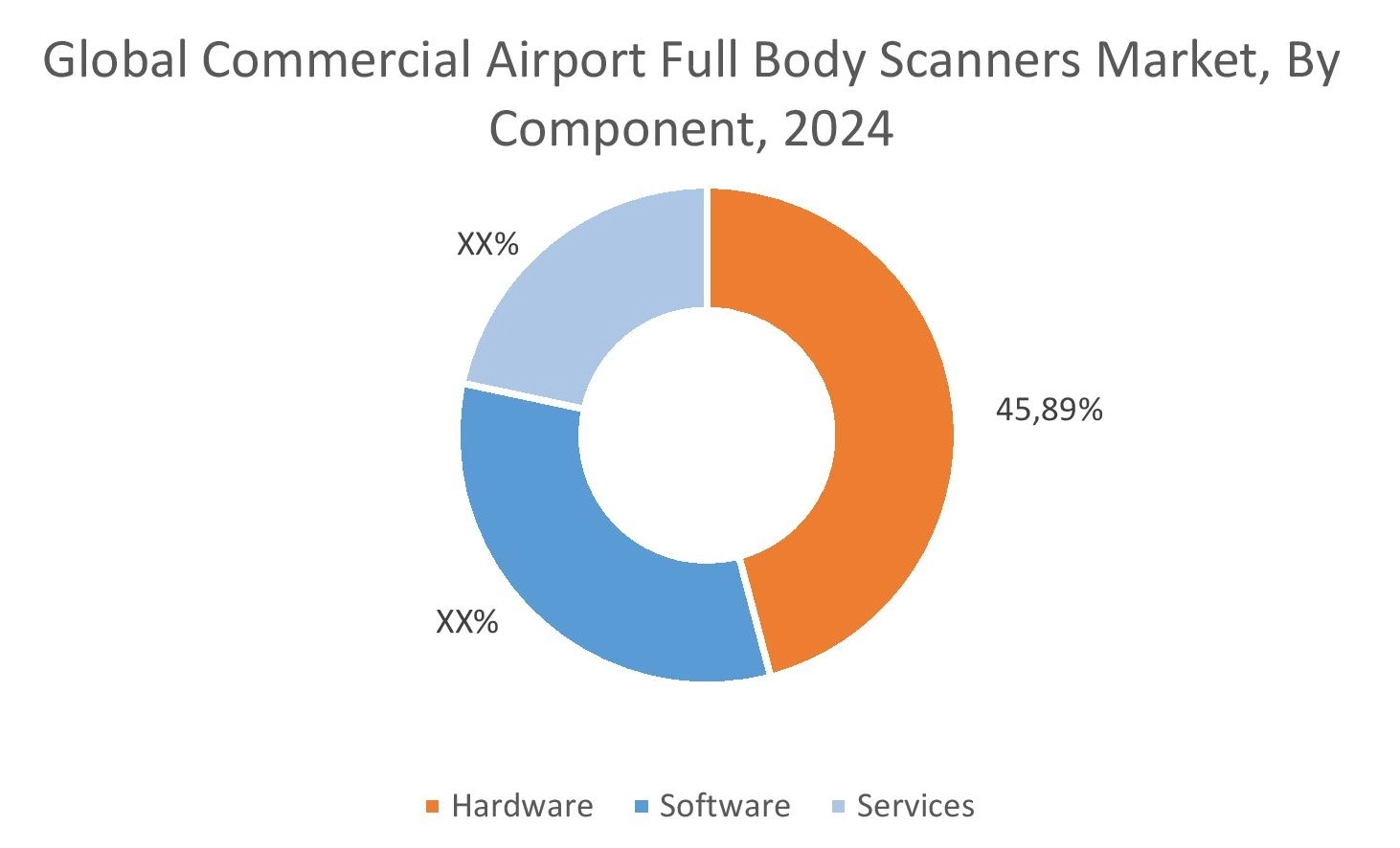
By View:
Based on the view, the market is segmented into single view, dual view, and 3D view.
Trends in the view:
- Increasing use of dual view in full body scanners for dual images inspection resulting in better security, in turn driving the market growth.
- Growing investments in scanners with three dimensional viewing capability for a better outline of the human body are driving the commercial airport full body scanners market share.
Dual view accounted for the largest revenue share in the market in 2024.
- Dual view full body scanners provide a comprehensive view of the human body by providing a head-to-toe view of the scan and an abdominal view, which helps in providing better security.
- Dual view body scanners typically utilize two X-ray generators that can operate at 170 kV, one generator for the full body and the other generator for the abdomen image.
- Moreover, many dual view full body scanners can handle a high throughput, which means a high number of scanned individuals per hour, in turn driving the commercial airport full body scanners market share.
- For instance, Westminster offers a dual view body scanner that provides high-quality imaging of the full body and abdomen in just 7 seconds.
- Therefore, based on analysis, the increasing use of dual view in full body scanners in commercial airports is driving the commercial airport full body scanners market size.
3D view is anticipated to register fastest CAGR during the forecast period.
- 3D view full body scanners provide a cartoon/animated outline of the person being scanned in a three-dimensional view.
- In 3D view full body scanners, the passengers enter large tubes where the scanning machine rotates around the passenger’s body to detect any prohibited objects.
- The growing need to protect the airplane and airports from threats or objects that might bypass the 2D view scanners has resulted in the growth of the 3D view segment.
- For instance, in June 2023, 3D body scanners were installed in the T3 domestic terminal at the Sydney Airport for enhanced security and high resolution images.
- Thus, as per analysis, the rising number of 3D view full body scanners is propelling the commercial airport full body scanners market during the forecast period.
Regional Analysis:
The regions covered are North America, Europe, Asia Pacific, the Middle East and Africa, and Latin America.
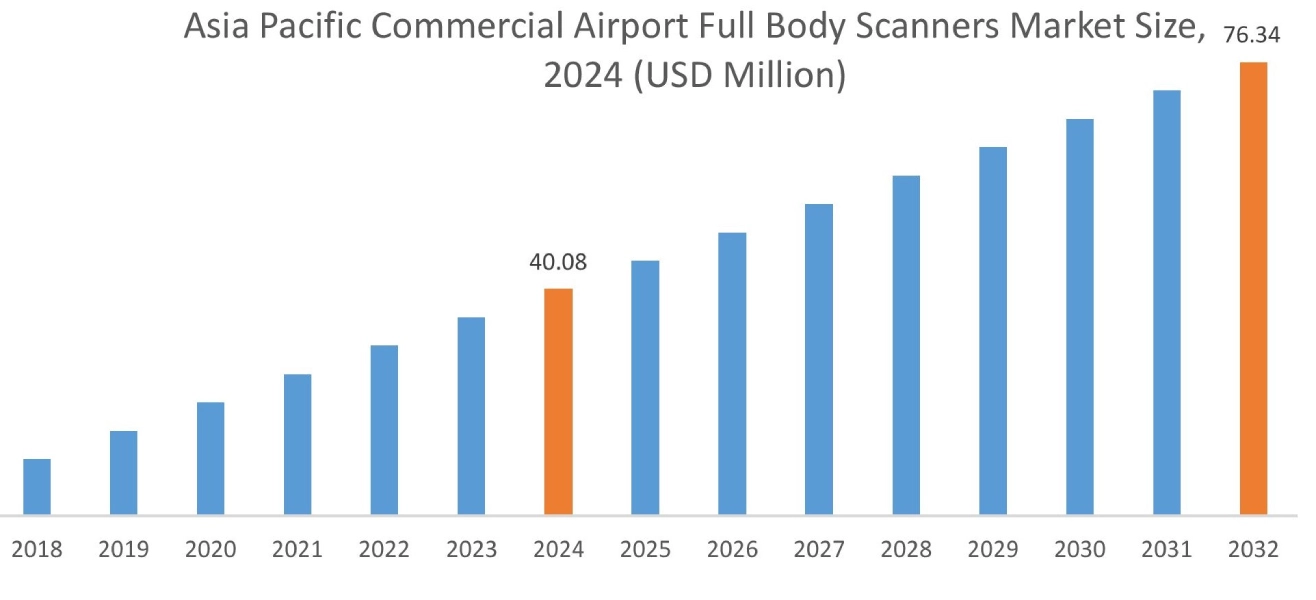
Asia Pacific region was valued at USD 40.08 Million in 2024. Moreover, it is projected to grow by USD 42.66 Million in 2025 and reach over USD 76.34 Million by 2032. Out of this, China accounted for the maximum revenue share of 29.12%. As per the commercial airport full body scanners market analysis, the adoption of commercial airport full body scanners in the Asia-Pacific region is primarily driven by the growing investments by governments to secure commercial airports, the growing utilization of software in full body scanners, among others.
- For instance, in February 2023, Smiths Detection announced the launch of an object recognition software that can help in automating the recognition of prohibited objects in places like commercial airports. The software uses artificial intelligence algorithms to automatically detect objects such as knives, scissors, and firearms. The increasing utilization of software to automate the recognition of contraband is expected to boost the overall market.
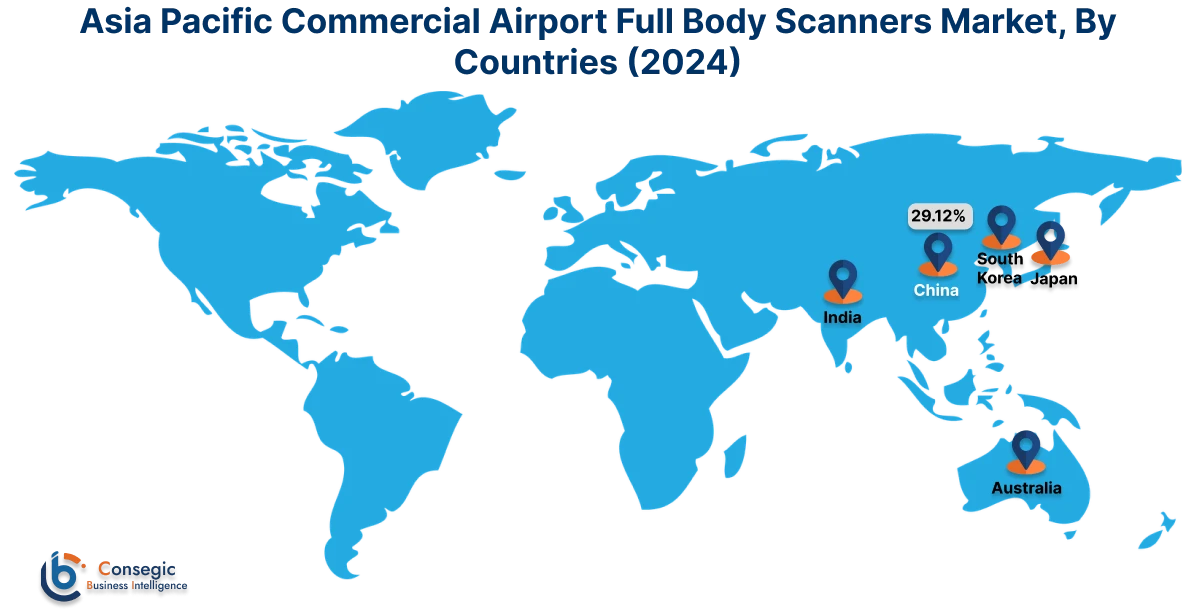
North America is estimated to reach over USD 88.05 Million by 2032 from a value of USD 47.80 Million in 2024 and is projected to grow by USD 50.74 Million in 2025. In North America, the development of the market is driven by the presence of a large commercial airport industry, a high volume of airport traffic, and the need to secure air traffic.
- For instance, the Hartsfield/Jackson Atlanta International Airport served approximately 105 million passengers in the year 2023. The growing number of airport traffic is expected to increase the need for airport security using full body scanners.
Additionally, the regional analysis depicts that the growing emphasis on full body scanning, which is non-invasive and not harmful to the human body, is driving the market demand in Europe. Furthermore, as per the analysis, the market demand in Latin America is expected to grow at a considerable rate due to the rising adoption of dual view full body scanners in airports. The Middle East and African region is expected to grow at a considerable rate due to factors like the increase in the development of commercial airplane fleets and the growing number of commercial airports, among others.
Top Key Players and Market Share Insights:
The global commercial airport full body scanners market report suggests the market is highly competitive with major players providing solutions to the national and international markets. Key players are adopting several strategies in research and development (R&D), product innovation, and end-user launches to hold a strong position in market. Key players in the commercial airport full body scanners industry include-
- Linev Systems (U.S.)
- Tek 84 Inc. (U.S.)
- Nuctech Company Ltd. (China)
- InsTech (Netherlands)
- Point Security Inc. (U.S.)
- Smiths Detection Group Ltd. (U.K.)
- Leidos (U.S.)
- Westminster Group Plc (U.K.)
- Rohde & Schwarz (Germany)
- Vehant Technologies (India)
Recent Industry Developments :
Market Expansion:
- In March 2025, Westminster Group, a leading manufacturer of full body scanners, announced that company had secured a 15+ year multimillion USD contract for security services in four airports in the Gabonese Republic.
- In April 2025, GMR Group announced that it had supplied four full body scanners for trials in the Delhi International Airport. The scanners use millimeter-wave technology that operates between 70 GHz to 80 GHz for enhanced security at the airport.
Commercial Airport Full Body Scanners Market Report Insights :
| Report Attributes | Report Details |
| Study Timeline | 2019-2032 |
| Market Size in 2032 | USD 267.31 Million |
| CAGR (2025-2032) | 8.5% |
| By Component |
|
| By Technology |
|
| By View |
|
| By Region |
|
| Key Players |
|
| North America | U.S. Canada Mexico |
| Europe | U.K. Germany France Spain Italy Russia Benelux Rest of Europe |
| APAC | China South Korea Japan India Australia ASEAN Rest of Asia-Pacific |
| Middle East and Africa | GCC Turkey South Africa Rest of MEA |
| LATAM | Brazil Argentina Chile Rest of LATAM |
| Report Coverage |
|
Key Questions Answered in the Report
How big is the commercial airport full body scanners market? +
The commercial airport full body scanners market is estimated to reach over USD 267.31 Million by 2032 from a value of USD 146.85 Million in 2024 and is projected to grow by USD 155.71 Million in 2025, growing at a CAGR of 8.5% from 2025 to 2032.
Which is the fastest-growing region in the commercial airport full body scanners market? +
Asia-Pacific region is experiencing the most rapid growth in the commercial airport full body scanners market.
What specific segmentation details are covered in the commercial airport full body scanners report? +
The commercial airport full body scanners report includes specific segmentation details for component, technology, view, and region.
Who are the major players in the commercial airport full body scanners market? +
The key participants in commercial airport full body scanners market are Linev Systems (U.S.), Smiths Detection Group Ltd. (U.K.), Leidos (U.S.), Westminster Group Plc (U.K.), Rohde & Schwarz (Germany), Vehant Technologies (India), Tek 84 Inc. (U.S.), Nuctech Company Ltd. (China), InsTech (Netherlands), Point Security Inc. (U.S.), and Others.
